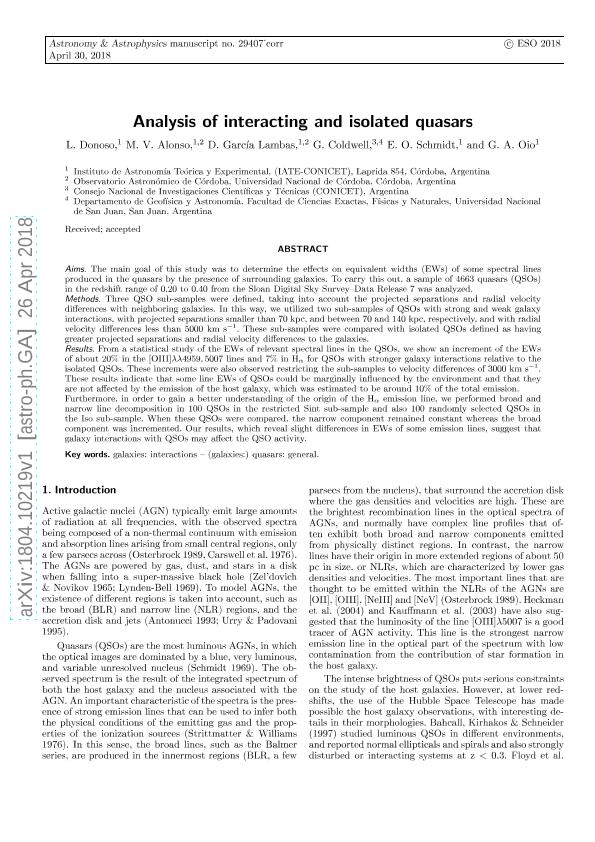Artículo
Analysis of interacting and isolated quasars
Donoso Navea, Laura Gema ; Alonso, Maria Victoria
; Alonso, Maria Victoria ; Garcia Lambas, Diego Rodolfo
; Garcia Lambas, Diego Rodolfo ; Coldwell Lloveras, Georgina Vanesa
; Coldwell Lloveras, Georgina Vanesa ; Schmidt, Eduardo Osvaldo
; Schmidt, Eduardo Osvaldo ; Oio, Gabriel Andrés
; Oio, Gabriel Andrés
 ; Alonso, Maria Victoria
; Alonso, Maria Victoria ; Garcia Lambas, Diego Rodolfo
; Garcia Lambas, Diego Rodolfo ; Coldwell Lloveras, Georgina Vanesa
; Coldwell Lloveras, Georgina Vanesa ; Schmidt, Eduardo Osvaldo
; Schmidt, Eduardo Osvaldo ; Oio, Gabriel Andrés
; Oio, Gabriel Andrés
Fecha de publicación:
07/2018
Editorial:
EDP Sciences
Revista:
Astronomy and Astrophysics
ISSN:
0004-6361
e-ISSN:
1432-0746
Idioma:
Inglés
Tipo de recurso:
Artículo publicado
Clasificación temática:
Resumen
The main goal of this study was to determine the effects on equivalent widths (EWs) of some spectral lines produced in the quasars by the presence of surrounding galaxies. To carry this out, a sample of 4663 quasars (QSOs) in the redshift range of 0.20 to 0.40 from the Sloan Digital Sky Survey data release 7 was analyzed. Methods. Three QSO sub-samples were defined, taking into account the projected separations and radial velocity differences with neighboring galaxies. In this way, we utilized two sub-samples of QSOs with strong and weak galaxy interactions, with projected separations smaller than 70 kpc, and between 70 and 140 kpc, respectively, and with radial velocity differences less than 5000 km s-1. These sub-samples were compared with isolated QSOs defined as having greater projected separations and radial velocity differences to the galaxies. Results. From a statistical study of the EWs of relevant spectral lines in the QSOs, we show an increment of the EWs of about 20% in the [OIII]λλ4959, 5007 lines and 7% in Hα for QSOs with stronger galaxy interactions relative to the isolated QSOs. These increments were also observed restricting the sub-samples to velocity differences of 3000 km s-1. These results indicate that some line EWs of QSOs could be marginally influenced by the environment and that they are not affected by the emission of the host galaxy, which was estimated to be around 10% of the total emission. Furthermore, in order to gain a better understanding of the origin of the Hα emission line, we performed broad and narrow line decomposition in 100 QSOs in the restricted Sint sub-sample and also 100 randomly selected QSOs in the Iso sub-sample. When these QSOs were compared, the narrow component remained constant whereas the broad component was incremented. Our results, which reveal slight differences in EWs of some emission lines, suggest that galaxy interactions with QSOs may affect the QSO activity.
Palabras clave:
GALAXIES: INTERACTIONS
,
QUASARS: GENERAL
Archivos asociados
Licencia
Identificadores
Colecciones
Articulos(CCT - SAN JUAN)
Articulos de CENTRO CIENTIFICO TECNOLOGICO CONICET - SAN JUAN
Articulos de CENTRO CIENTIFICO TECNOLOGICO CONICET - SAN JUAN
Articulos(IATE)
Articulos de INST.DE ASTRONOMIA TEORICA Y EXPERIMENTAL
Articulos de INST.DE ASTRONOMIA TEORICA Y EXPERIMENTAL
Citación
Donoso Navea, Laura Gema; Alonso, Maria Victoria; Garcia Lambas, Diego Rodolfo; Coldwell Lloveras, Georgina Vanesa; Schmidt, Eduardo Osvaldo; et al.; Analysis of interacting and isolated quasars; EDP Sciences; Astronomy and Astrophysics; 615; 7-2018; 11-19
Compartir
Altmétricas



